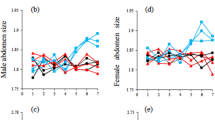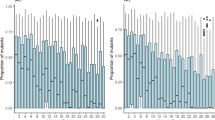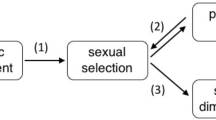Abstract
Fisher1showed that frequency-dependent selection will stabilize balanced sex ratios of parental investment2, under a wide range of mating systems and patterns of mortality. But many actual ratios of investment are biased. Some of these can be explained by models3–14in which the life history lacks certain kinds of symmetry that are present in Fisher's model. For example, where brothers compete directly for matings, female biases are expected and found3,9. Here I describe a model for the evolution of sex ratios in species having two generations per year with an asymmetrical pattern of overlap between the generations. Many insects have partially bivoltine life histories of this kind. Two predictions emerge from an analysis of the model. First, one of the two generations produced each season will be female-biased, and the other will be male-biased. Second, eusociality will arise more often in haplodiploid species that overwinter as inseminated females than it will in those that overwinter as larvae or as unmated adults. Data on the sex ratios of bivoltine solitary Hymenoptera and on the phylogenetic distribution of eusociality are consistent with these predictions. Thus the model shows one particular way in which ecological and genetic variables may interact to encourage the evolution of eusociality in some species and to discourage it in others.
This is a preview of subscription content, access via your institution
Access options
Subscribe to this journal
Receive 51 print issues and online access
$199.00 per year
only $3.90 per issue
Buy this article
- Purchase on Springer Link
- Instant access to full article PDF
Prices may be subject to local taxes which are calculated during checkout
Similar content being viewed by others
References
Fisher, R. A. The Genetical Theory of Natural Selection (Oxford University Press, 1930).
Trivers, R. L. in Sexual Selection and the Descent of Man 1871–1971 (ed. Campbell, B.) (Aldine, Chicago, 1972).
Hamilton, W. D. Science 156, 477–488 (1967).
Trivers, R. L. & Willard, D. E. Science 179, 90–92 (1973).
Trivers, R. L. & Hare, H. Science 191, 249–263 (1976).
Charnov, E. L. & Bull, J. Nature 266, 828–830 (1977).
Clark, A. B. Science 201, 163–165 (1978).
Werren, J. H. & Charnov, E. L. Nature 272, 349–350 (1978).
Werren, J. H. Science 208, 1157–1159 (1980).
Bulmer, M. G. & Taylor, P. D. Nature 284, 448–449 (1980).
Bull, J. J. Heredity 46, 9–26 (1981).
Charnov, E. L., Los-den Hartogh, R. L., Jones, W. T. & Assem, J. van den Nature 289, 27–33 (1981).
Charnov, E. L. Am. Nat. 112, 317–326 (1978).
Charnov, E. L. Am. Nat. 113, 465–480 (1979).
Travis, C. C., Post, W. M., DeAngelis, D. L. & Perkowski, J. Theor. pop. Biol. 18, 16–30 (1980).
Simon Thomas, R. T. & Poorter, E. P. R. Tijdschr. Ent. 115, 141–151 (1972).
Alcock, J. et al. Zool. J. Linn. Soc. 64, 293–326 (1978).
Gwynne, D. T. Behav. Ecol. Sociobiol. 7, 213–225 (1980).
Evans, H. E., Anim. Behav. 21, 302–308 (1973).
Hamilton, W. D. J. theor. Biol. 7, 1–16 (1964).
Hamilton, W. D. Ann. Rev. Ecol. Syst. 3, 193–232 (1972).
Craig, R. J. theor. Biol. 87, 55–70 (1980).
Wilson, E. O. The Insect Societies (Harvard University Press, 1971).
Michener, C. D. The Social Behavior of the Bees (Harvard University Press, 1974).
Stephen, W. P., Bohart, G. E. & Torchio, P. F. Biology and External Morphology of Bees (Agricultural Experiment Station, Oregon State University, Corvallis, 1969).
Michener, C. D. & Bennett, F. D. Univ. Kansas Sci. Bull. 51, 233–260 (1977).
Fye, R. E. Can. Ent. 97, 716–744 (1965).
Danks, H. V. Trans. R. ent. Soc. Lond. 122, 323–399 (1970).
Longair, R. W. Evolution 35, 597–600 (1981).
Author information
Authors and Affiliations
Rights and permissions
About this article
Cite this article
Seger, J. Partial bivoltinism may cause alternating sex-ratio biases that favour eusociality. Nature 301, 59–62 (1983). https://doi.org/10.1038/301059a0
Received:
Accepted:
Issue Date:
DOI: https://doi.org/10.1038/301059a0
This article is cited by
-
Sex Ratio, Sexual Dimorphism, and Wing Geometric Morphometrics in Species of Trypoxylon Latreille, 1796 (Hymenoptera: Crabronidae)
Neotropical Entomology (2023)
-
Origin of an evolutionary novelty: the worker phenotype of eusocial wasps
Insectes Sociaux (2021)
-
Split sex ratios and genetic relatedness in a primitively eusocial sweat bee
Behavioral Ecology and Sociobiology (2021)
-
Monogamous sperm storage and permanent worker sterility in a long-lived ambrosia beetle
Nature Ecology & Evolution (2018)
-
Division of labour and the evolution of extreme specialization
Nature Ecology & Evolution (2018)
Comments
By submitting a comment you agree to abide by our Terms and Community Guidelines. If you find something abusive or that does not comply with our terms or guidelines please flag it as inappropriate.



